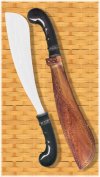Probably one doesn't hear too much any more because Jean-Marc and I moved on. But basically I've been using my Valiant blades for many years, and I've sure cleared a lot of trails.
The simple machete can be made a great deal more effective by flattening and then convexing the flats, then grinding or honing the bevels, starting 1/2" to 1" behind the edge. Then the machete won't bind if chopped into a log, and surprising the far more acute edge will hold vastly longer when used for cutting tough north American stuff such as devil's club or hardhack. Those will reduce a normal V edge to a saw edge in minutes. No-one would ever belive that without trying, so it's a sort of test of practical experience.
I had moved on to Valiant blades before that after seeing devil's club trash a machete in seconds and wanting to test Jean-Marc's upstart claims.
Properly set up, a golok, parang (and etc.. since those are just terms for big knife) will lead one to the draw cut,which firstly will happen suddenly and by accident. You know when it has happened because the blade moves through stuff which should have stopped it and doesn't lose speed. And that is a real problem for any body parts in the path of the blade.
My favorite user experience is where I get to look like a total idiot. It's good to be able to do that and actually come back with body parts attached. My grand-daughter wanted to use my "pirate swords". I was against that because when the draw cut suddenly happens there is some danger. So I said that I would show her just what could happen. We chose an alder sapling which she thought couldn't be chopped in one chop. There was a suitable blocker sapling next to it. So the idea was that I would cut through the sapling and the blade would continue and get stuck into the blocker (preventing injury). I would then catch the butt of the falling sapling on my shoulder and move it. That's how old people clear trails alone.
Anyway my grand-daughter gave me great confidence with comments like (well they were very negative so we can leave those out). I got upset and determined that i would make a perfect stroke and that the sapling would fall.
When the blade sailed though both the sapling which was supposed to come down and the blocker, no body parts were in the path. Of course then I figured I couldn't hold big two saplings, the branches locked together - and they fell on me.
I like that story because it shows how we can go under when showing off. More important to me, when using the other hundreds of thousands of draw cuts without getting prideful, nothing went wrong.
I believe any collector of blades who doesn't have a lot of clay zone hardened edges is delusional. Likewise for not having strictly poured water hardened bladed like Kuks. I learned to appreciate primitive heat treat before I gained a grasp of traditional designs working better because of those millions of hours of development. The trouble with Kuks working beyond normal imaginings is that they require a reverse draw cut, That can cause glancing trouble if you don't get it right.
I haven't ordered one recently, but Wandi was best known from when he was out of communication because of family problems in Indonesia - then paid everyone 10% for their trouble of being worried while he was out of communication.
Because I live in a really damp place, all of my horn handles and all wooden handles except one have held up well. That's remarkable since I'm still testing, and so not taking special shrinkage precautions. People are not posting a lot of shrinkage precautions since each bit of extra slipperiness on the handle could mean more chance of losing a limb.
A person starts with the survival golok and learns the draw cut. Learning the draw cut is what makes everything worthwhile. From then you can make your own decisions.
Hard wood and soft wood are terms which describe the seasoned product. So hard woods here are softer than softwoods when green.
Know what you want. If firewood - obviously seasoned wood needs to be cut into sections and split, then think axe for efficiency. but a machete/golok.tiny hatchet will work. And so will a leuku....
http://www.oldjimbo.com/survival/tinyhatchets2.html
I was very indignant when I put up that page because I'd been called a BSer for promoting a tiny hatchet. The original question was "Show me what you can split." But I've been retired a while and I haven't yet showed splitting that 6' diameter cedar. You might want to see some pictures of the grain in the roots before laughing too loudly. Traditionally people who try to cut or split root areas are laughed at, because the work is so difficult.
You all know what kinaesthetic memory is because on forgetting how to spell a word, you have "written it in the air". And so you know that the process isn't reversible. But learning how to do the draw cut, sharpen a blade or a saw is wonderful enough that it isn't an imposition.







